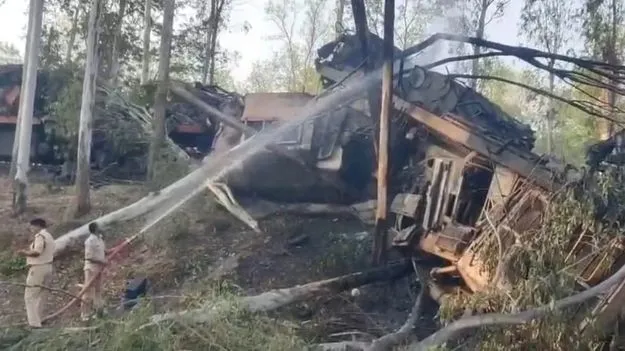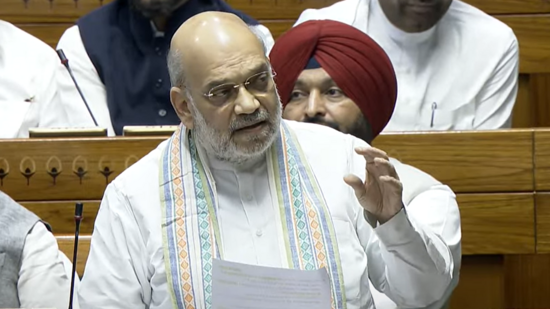
On April 1, 2025, a Deadly Train Accident in Jharkhand, which led to the loss of three lives and left several others injured. This accident took place in the Sahebganj district when two freight trains collided, causing significant damage and raising serious concerns about railway safety in India.
What Happened in the Jharkhand Train Collision?
The accident occurred early in the morning at around 3:30 AM on the Farakka-Lalmatiya MGR railway line in the Barhet police station area of Sahebganj district. A fast-moving coal-laden freight train crashed into an empty, stationary freight train that was waiting at the Barhet MT station.
The crash caused massive destruction and resulted in a fire breaking out in one of the trains, which was carrying coal. The collision and fire made the situation even worse. Sadly, three railway personnel, including two locomotive pilots, lost their lives in the incident. Several other workers were injured and rushed to the hospital for treatment.
Possible Causes of the Collision

Early reports suggest that the collision might have occurred due to a failure in communication between the two trains. Clear communication and signaling are essential for preventing accidents like this, but it seems that these systems failed in this case.
The stationary freight train was waiting at the station when the coal-laden train, coming from the Lalmatiya side, crashed into it because the driver couldn’t stop in time. The force of the crash was so strong that the train carrying coal caught fire, making the situation even more dangerous for the railway staff at the scene.
This accident shows how important it is to improve communication systems and railway infrastructure, especially in remote areas where safety technologies may not always be up to date.
Loss of Life and Injuries
The crash claimed the lives of three people, including the two locomotive pilots who were operating the trains when the accident occurred. The crash was so intense that the pilots did not survive.
Additionally, around four to five railway workers sustained injuries. Some of them were seriously injured and had to be taken to the Community Health Center in Barhet for medical attention. Emergency teams and local authorities arrived quickly to help with the situation and provide necessary support.
The Impact and Aftermath of the Train Collision
After the crash, railway authorities and security forces responded quickly. Teams from the Central Industrial Security Force (CISF) and railway officials were sent to the scene to assess the damage and manage the situation.
The crash led to a fire in the engine of one of the trains, which made it even harder to handle the aftermath. Firefighters worked hard to control the fire, while medical teams helped transport the injured workers to local hospitals. Train services on the affected railway line were stopped temporarily, and efforts are being made to restore normal operations as soon as possible.
Railway Officials Respond and Investigate
The Indian Railways has expressed condolences to the families of those who died in the accident. They have launched a detailed investigation to determine the exact cause of the crash. Railway officials are investigating whether the accident happened due to human error, a mechanical failure, or a problem with the signaling system.
The Railway Minister has promised that steps will be taken to prevent similar accidents in the future. An inquiry committee has been formed to look into what went wrong, whether negligence played a role, and how to improve safety in the future.
One important issue raised by the accident is the transportation of hazardous materials like coal. The fire that started after the crash has led to questions about whether the right safety measures are in place when transporting flammable goods by rail.
Why Railway Safety Needs to Improve
This tragic incident serves as a reminder that railway safety in India needs to be improved. To prevent such disasters, it is essential to combine modern technology, proper maintenance, and well-trained staff.
Some of the important safety measures that need attention include:
- Better Communication Systems: Improved communication between railway stations and moving trains can help prevent accidents caused by miscommunication.
- Updated Signaling Technology: Upgraded signaling systems are needed to avoid collisions, especially in areas where manual operations are still used.
- Regular Track and Train Maintenance: Ensuring that trains and tracks are regularly maintained can prevent accidents caused by technical failures.
- Safety Protocols for Hazardous Materials: Stricter safety guidelines are necessary when transporting flammable materials like coal to prevent fire hazards in case of accidents.
While India has made progress in modernizing its railway system, accidents like this show that more needs to be done.
The Role of CISF in Managing the Situation
The Central Industrial Security Force (CISF) played a key role in managing the aftermath of the crash. They arrived quickly to secure the site and assist with rescue operations. Their presence was especially important in controlling the fire that broke out after the collision.
CISF teams helped prevent further dangers and worked alongside railway officials to investigate the cause of the accident and support recovery efforts. Their timely response ensured that the situation didn’t get worse.
The Future of Railway Safety in India
This deadly train accident in Jharkhand highlights the risks that railway workers face every day. As authorities continue to investigate the cause of the crash, it is essential to focus on preventing such incidents from happening in the future.
Railway safety reforms need to be accelerated to protect not only passengers but also the dedicated railway workers who operate freight trains. Investments in modern technology, better training for railway staff, and stronger safety protocols are necessary steps toward making Indian railways safer for everyone.
The families of the victims are grieving their loss, and the injured workers are receiving medical care. In the coming weeks, more details will be available regarding the cause of the crash. However, it is clear that stronger safety measures and better infrastructure are urgently needed to prevent similar tragedies in the future.
This incident should serve as a wake-up call for railway authorities to prioritize safety and modernization. By doing so, they can ensure that both workers and passengers have a safer, more reliable railway network in the future.






